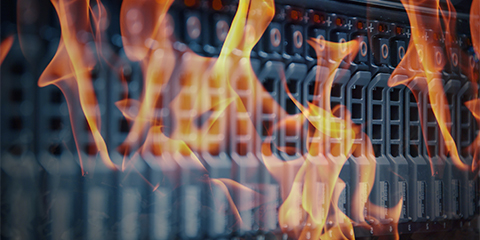- News & Resources: Listings >
- Blog
- How OCWA modernized water infrastructure with Cisco industrial IoT
- Redefining physical security in healthcare: A response to rising violence
- Emerging Cyber Threats in 2025: Tactics Redefining Digital Risk
- The Three Shields: How Firewalls Defend Modern Enterprises
- Workplace Safety in Crisis: Protecting Frontline Workers from Rising Threats
- The Role of Industrial Networking in Modern Manufacturing
- Why Cybersecurity for SMBs Must Be a Top Priority in 2025
- Together We Give: CMN and Umbrella’s Commitment to Support our Community
- The State of Shoplifting report reveals that 24% of shoppers switch stores due to shoplifting.
- How to Improve Safety and Security in Schools – Cloud Manage Network
- Top 10 Cybersecurity Threats in 2024
- Microsegmentation: Protecting Data from Cyber Threats
- Retail shoplifting and loss prevention: How to protect your business
- Generative AI Cost Optimization Strategies
- Why Do I Need to Protect My Cloud?
- 10 Reasons for Engaging Outside Experts to Manage Your Cybersecurity
- Why Hiring a 3rd Party MSP Expert Makes Sense and – and Cents (MANY cents!)
- Brand and Network Considerations When Adopting AI Corporately
- Integrating XDR, SIEM, and SOAR
- 3-2-1 –Go? Not so quick, this time.
- 5 Things a CISO Shoud Know
- 10-Step Patch Management Checklist
- Penetration Testing vs. Breach Attack Simulation
- Current big cyber breaches and impact on businesses
- Smart Infrastructure Gets Lit Up!
- Securing Industrial IoT: The Missing Puzzle Piece
- 7 Common Cybersecurity Mistakes Made by SMBs
- The Future of Physical Security: Cloud-Based Systems
- Autonomous and Sensor Technology Use Surging
- 2024 Facilities Trends Will Require Facilities and IT Teams to Work in Tandem
- NGFW vs. WAF. What’s the Right Firewall for You?
- Chris Hadfield’s Words To Live By
- Industrial Revolution 4.0 + IIoT
- Digital Fluency Drives Innovation
- Your Cloud Needs Protecting, Too
- Your building alarm systems could become obsolete. In 2024!
- Zero Trust 2.0: Zero Trust Data Resilience (ZTDR)
- We just got, or got used to, Wi-Fi 6. What is Wi-Fi 7?
- What Does the Board Need to Know? Business Metrics that CISOs Should Share – 4th and Last in a Four-Part Series
- Why 2024 is the Year for AI Networking
- International Women’s Day is Tomorrow – Great Time to Think About…
- Data-Centric Security Step One: Classifying Your Data
- The Network – Unsung Hero of Super Bowl LVIII
- What Does the Board Need to Know? Business Metrics that CISOs Should Share – Third in a Four-Part Series
- Boosting IT Team Performance by Fostering Intuition, Curiosity and Creativity
- Breach Remediation Costs Can Wipeout Bottom Line and Business
- Hoodied Hackers Now Favour Hugo Boss
- What Do You Need to Tell the Board? Business Metrics that CISOs Should Share – Second in a Four-Part Series
- How to Get People to Re-Engage After the Holidays
- What Does the Board Need to Know? Business Metrics that CISOs Should Share – First in a Four-Part Series
- Android Devices MUST be Updated + IT Departments Being Cut as Privilege Escalation Escalates
- Today’s Common Cloud Migration and Management Concerns
- Protect Your Healthcare Network from Cyberattack – Lives are at Stake
- Happy Halloween: Black Cats Lead to Boo….Hoo.
- Insurance Underwriters are Protecting Their Flanks
- Insurance Companies Cracking Down as Cybercriminals Become Better Business Builders
- Scary Cyberattacks Stats
- Parents, Profs and IT Professionals Perceive Back-to-School Through Different Lens
- Zscaler’s new IDTR and other tools that leverage generative AI
- Vanquish Vaping, Vandalism and Villainy
- Fabric for Fast-Paced Environments
- Changes to Cyber Insurance Requirements – What you Need to Know
- Cybersecurity Readiness – Newly Released Report
- Passwords Leaked…Again
- 10-Step Patch Management Checklist
- Remote – Again – For Now… and Still Maintaining Engagement
- Protecting Pocketbooks, Passwords and Property from Pilfering
- Raspberry Robin: Highly Evasive Worm Spreads over External Disks
- Cisco Introduces Responsible AI – Enhancing Technology, Transparency and Customer Trust
- Managing Customer Trust in Uncertain Supply Chain Conditions
- Hope on the Horizon
- Toys of Tomorrow… What will spark your imagination? Fuel your imagination?
- Protecting Purses and Digital Wallets
- The Password that Felled the Kingdom + MFA vs 2FA
- The MOE’s RA 3.0 and Zscaler
- 7 Critical Reasons for MS Office 365 Backup
- Penetration Testing Important, but…
- Social Engineering and Poor Patching Responsible for Over 90% of Cybersecurity Problems
- Breach Incidence and Costs On the Rise Again + 5 Ways to Reduce Your Risk
- Cybersecurity Insurance Policies Require Security Audits and Pen Testing
- Wireless strategies for business continuity gain importance as enterprise expand IoT, cloud, and other technologies
- How Cybercrooks are Targeting YOU
- Enabling Digital Transformation with Cisco SD-WAN
- WFH Post Pandemic – What It Will Look Like. What You’ll Need.
- Leaders to looking to the IoT to improve efficiency and resiliency
- Cyber Security Vernacular – Well, some of it, for now
- Why You Need Disaster Recovery, NOT Just Back-Ups
- 10 Reasons Why Having an Expert Manage Your Cybersecurity Makes Sense and Saves Dollars
- Converting CapEx IT Investments into Manageable OpEx
- The Hybrid Workplace – Planning the Next Phase
- Cisco Cloud Calling: Empowering Customers to Thrive with Hybrid Work
- When You Can’t Access the Cloud
- How to Keep On Keeping On
- New Cisco Research Reveals Collaboration, Cloud and Security are IT’s Top Challenges
- Threats from Within on the Rise
- Cloud Covered? If Not, Take Cover!
- Zero Trust and Forrester Wave Report
- Password Based Cyber Attack: Like Leaving Keys Under Doormats
- So, What’s Up With Sensors?
- Sensors and Systems Create a Digital “Last Mile” and Help Skyrocketing Costs
- Scanners Provide Peace of Mind for Returning Students and Workers
- Sensors Improve Operations and Bottom Line… Easily and Cost-Affordably.
- Cisco Meraki Looks at 2021
- 2020 Holiday Shopping: Cybersecurity and Other Tips to Safeguard Wallets and Systems
- How to make the most of the technology you have
- Personnel, Planet and Business Progress: More Interdependent Than Ever Before
- Sure… you can get them all in the boat – but can you get them to work well together?
- Pushing the Zero Trust Envelope – Cisco is Named a Leader in the 2020 Forrester Zero Trust Wave
- Cloud Data Must be Protected, Too!
- Don’t Let Anyone Get the Dirt on You – Make It Instead!
- How IoT Devices Can Help You and Your business
- WebEx – A World of Possibility
- Creating Your Breach Response Plan Now Will Save You Thousands Down The Road
- Been hacked? Here’s what you must do next.
- The Need for Pen Testing is At an All-Time High
- 5 Ways an IT Reseller Improves Your Performance and Peace-of-Mind
- 5G and Wi-Fi 6: Faster, more flexible, and future ready. Are you?
- Network and Data Security for Returning and Remote Workers + Disaster Recovery Symposium
- Collaboration and Cisco WebEx: Protecting Your Data
- Thursday’s Virtual Conference Tackles Today’s Supply Chain Trials and Tribulations
- 10 Tips to Reduce Cloud Storage Risk
- COVID-19 Crisis Fuelling IT Spending
- Supply Chain/Logistics Experts Share Their Expertise
- Cisco Breach Defence Overview
- Announcing Our New Website and Blog

Tired of reading something you already know? Namely that your data and systems are vulnerable to outside attack? Totally get that. We’re going to talk about why you need disaster recovery systems in a moment, but first let’s consider there are five other key reasons why your network might crash:
1. Power Failures. It may be hard to believe, but power failures were the number one cause of data centre and organisational network failures last year.
As we said in our April 8th blog post, you can minimize your risk by having backup generators, Uninterruptible Power Supplies (UPS), multiple servers and other off-site redundant systems. A UPS will help keep networks, equipment, point-of-sale terminals, laptops and other critical tools running in a power failure, helping to prevent data loss and apparatus damage, until your generator kicks in… or at least until you are able to shut down everything safely, if you don’t have a backup generator. Sometimes, that buffer can be the difference between being able to get up and running again quickly, or not.
2. Mother Nature is becoming increasingly unpredictable and powerful. In 2020, record numbers of floods, hurricanes and wildfires caused over $210 billion in damage, according to a major insurance firm. These natural disasters were also responsible for a 15% increase in system failures. Regular fires – though business owners would call these anything other than “regular” – added a couple of percentage points, too.
Scary stat: According to FEMA (The Federal Emergency Management Agency in the US), “nearly 40% of small businesses fail to reopen after being hit by a natural disaster.”
3. Software Problems. In previous posts, we’ve talked about software upgrades and poorly patched programs creating gaps – backdoors, if you will – for cybercriminals to get in and wreak havoc. Even without malware and ransomware getting past your firewalls, system “enhancements” can still cause network and endpoints to malfunction. Indeed, they are a leading cause of system crashes and/or data being lost.
4. Hardware Failure. Thanks to the software updates mentioned above, improved hardware quality and climate-controlled environments, servers, routers, switches and other essential items last longer now than they did five years ago. Nevertheless, like everything, hardware is susceptible to wear and tear, accidental damage and aging. Eventually, most hardware will either become obsolete or fail.
At least 10% of major system crashes were the result of hardware problems in 2020. In many instances, companies try to save money by making equipment last a little longer, only to pay thousands upon thousands in recovery-related fees. This really is a case of being penny wise and pound foolish.
Again, it makes sense to have “spares” of critical hardware in inventory. Many factories do this with key assembly-line components, hospitals do so with monitoring equipment… even new moms make sure they have an extra soother on hand, just in case.
5. Human Error. Although there has been an increase in internal security breaches and “sabotage” since the pandemic began, the vast majority of problems come from lack of training or simple mistakes. Simple in that a small coding “typo” can fell a system; not so simple in terms of the aftermath.
A widely told story is one of AWS (Amazon Web Services)’s recent crash. An incorrect command, a small typo if you will, took servers off-line globally for hours. In that case, it really was an IT disaster.
What about “simple” data loss?
Over 75% of North American businesses have experienced some degree of data loss through breaches, deletion (unintentional or malicious), disk or system failure, viruses, fire or natural disaster.
 |
Why Disaster Recovery is Essential and DRaaS is an Excellent Option Just about every IT article today talks about cloud usage, and the need for cyber security and data protection. Every other article talks about businesses trying to figure out how to return to “near normal”. And ‘hybrid’ seems to be the buzzword they all have in common. |
But there’s no going back when it comes to data backup and disaster recovery, no hybrid option that is truly effective.
As organisations replace legacy systems – with many having been forced into upgrading solutions and introducing highly-distributed networks ahead of schedule – to support their newly-remote workforce and stakeholder networks, backup and disaster recovery approaches also need to be catapulted forward, to respond to today’s “new normal”. Sorry; I couldn’t resist.
Organisations capture, use, retain and protect exponentially more data today than was the case even five years ago. With increasing adoption of Ai and IoT devices, data management requirements will continue to escalate.
At the same time, we’re seeing converged architectures starting to replace multi-tier architectures, greater migration to the cloud and increasing adoption of diverse applications.
Legacy backup systems can no longer guarantee that you’ll be up and running again quickly, if disaster strikes – especially if your infrastructure has changed since the system was first introduced.
Virtualization, the traditional tape backups of data and software solutions, is no longer enough. That can not guarantee you’ll be able to get up and going quickly, as everything would need to be reinstalled, reconfigured and verified before your operation could resume.
Today, instead, you need snapshots, live migrations and full replication. As the name suggests, this will give you an identical replica of all data, applications and infrastructure architecture at an off-site location. Snapshots protect data and make quick restores possible when a small event occurs. With replication, multi-cloud backup solutions automatically track and back up everything. Should you suffer a full network crash, your business can be up and running in moments. No data lost. No time lost. No harm to company reputation or bottom line.
For this reason, IT professionals are increasingly looking to third-party experts for assistance and engaging BaaS (Backup as a Service) and Disaster Recovery as a Service (DRaaS) providers.
Why third parties?
• The biggest one: Knowing there’s a team of experts ready to step in when the system goes down. They will have dealt with such calamities on many, many occasions and will know exactly what to do. Hopefully, you’ll only go through this once, if at all. You don’t want to be figuring things out for the first time when everyone in the company is breathing down your neck.
According to Disaster Recovery (DR) experts, even companies that routinely practice restoring their systems – and a surprisingly low percentage of firms do so – flounder when disaster actually strikes.
• Having DR experts to work with your IT and Senior management team, and review your Disaster Recovery protocols and procedures, or to help you develop your disaster recovery strategy and plan. They can help you prioritize which applications should be restored first, based on your business needs and goals.
• Lower costs – the ability to have state-of-the-art technology working for you, without having to continuously invest in the latest and greatest software solutions. There’s also the cost of data storage to consider.
• Reduced overhead counts – ensuring backup and recovery systems are working at 100% requires 7/24/365 care from a seasoned specialist. Most organisations can’t afford to have three such experts on staff.
• Having a dedicated off-site repository, without the cost or complexity of managing a second infrastructure.
• Greater flexibility and scalability.
• Lower probability of failed data backup. Over 20% of companies that manage their own backup are unable to restore all data when disaster strikes, because of errors that can occur in the backup process.
Why is this figure so high? There are many different ways back up data (full, incremental, differential, mirror, local, cloud, remote, FTP, etc.), yet less than 50% of firms use more than one approach.
When creating your Disaster Response Plan, and making decisions about how to approach back-up, recovery and restore, you need to consider two key things:
1. RPO (Recovery Point Objective). You need to determine how much data you are prepared to lose, both collected and lost data capture from system downtime.
2. RTO (Recovery Time Objective). This talks about the amount of time you are willing to have an application be down, taking into account the impact on other systems, the business overall, client needs and expectations, the brand’s reputation and, ultimately, your bottom line.
As North American business needs continue to evolve, and the backup and disaster recovery industry keeps pace, IT professionals often need advice in terms of the best way to proceed. We would be happy to act as a sounding board – no strings attached.
We would to hear from you. Please feel free to contact us at [email protected] or (416) 429-0796 or 1.877.238.9944 (Toll Free).
P.S. One of our partners, Veeam, is a leading player in the Backup and Disaster Recovery industry. To read the latest about how Veeam provides backup for Microsoft Office 365, please click here.

